Duplicate records
Overview
The Duplicate records page displays person's (contacts) and accounts (previously organization) records that Ortto has identified as duplicates, determined by their primary unique identifier.
Accessing duplicate records
To access the duplicate records page, go to Settings > Customer data > Duplicate records
Managing duplicate records
The duplicate records page allows users to:
Viewing duplicate records
- Within the Duplicate records page, you can toggle between person and account records.
- Use the view menu located on the top right-hand side to switch between different record types seamlessly.

While this page primarily addresses the resolution of duplicate person records, the process remains largely similar for account records.
NOTE: The record designated as Primary on the Duplicate records page is determined by the primary merge rule. You can adjust this rule by clicking on the cog icon and selecting your desired preference. Both the primary record and the merge rule are flexible and can be modified based on your chosen method for merging duplicate records. Keep reading to explore further details.
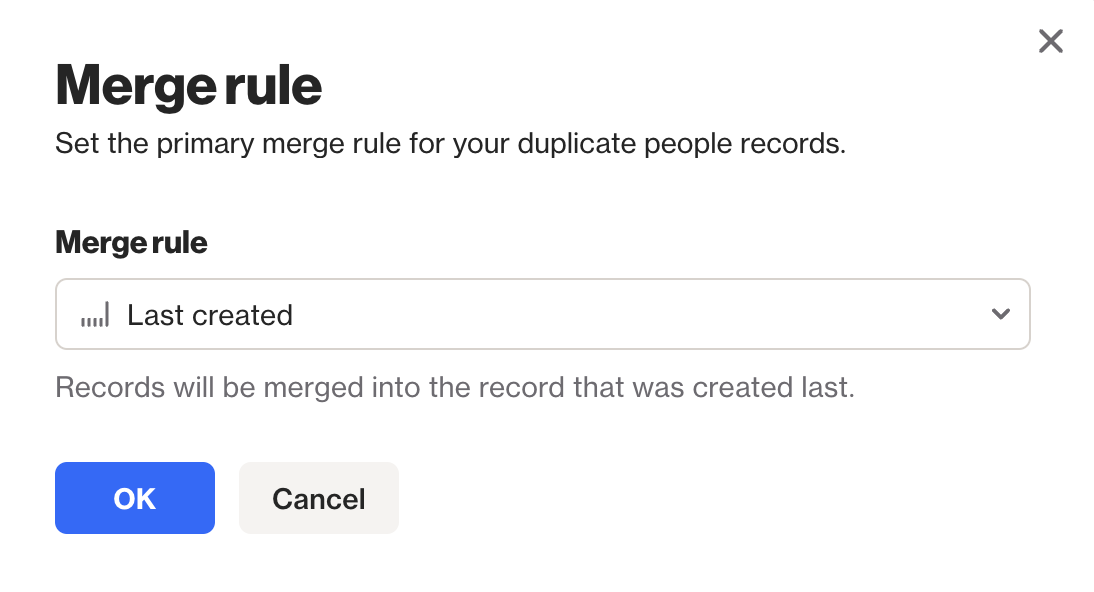
Manage duplicate records
Ortto has identified 3 person records with the same email address: “emily@example.com”.

Resolving duplicate records
Duplicate records can be resolved in two ways:
Selecting a primary record: Choose a specific record to be the primary one and merge the other duplicate records into it.
- Navigate to Duplicate records.
- Choose the desired record to serve as the Primary record.
- Select Preview merge.
- Confirm the merge by selecting Confirm merge.
Based on recent interaction or age: Select a record based on a recent interaction or age to be the primary one and merge the other duplicate records into it.
- Select Merge all
- Choose the appropriate Option from the dropdown menu.
- Type "Merge (number of relevant contacts) people records" to continue
- Select Merge
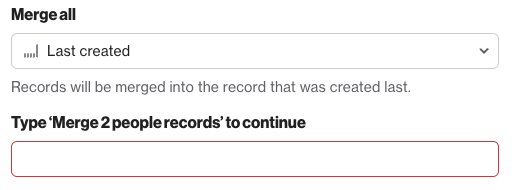
NOTE: Activities are not merged, any records belonging to the non-primary contacts will not be copied to the primary contact.
Merging duplicate records
When merging duplicate records:
- If a value exists for a field on the primary contact record, the primary data is retained.
- If no value exists for a field on the primary contact record, the value is set using data from a non-primary record.
Effects on audiences
Upon merge, if data in a merged record qualifies the contact for an audience they were not previously a part of, they will enter into this audience. Similarly, if the merge causes a contact to no longer meet the criteria for an audience, they will exit from that audience.
For a more in-depth understanding of how records are merged, please refer to the following section.
Merge duplicates to a specific primary record
In the list of duplicates, select the person record that you’d like to identify as the primary record. The primary record is the one with which other (non-primary) records will be merged.
Once you’ve identified the primary record, you have the option to merge either all or select duplicate records.
- To merge all records, select the bulk selection checkbox in the top-left of the records table.
- To merge only specific records, select the checkboxes next to the relevant entries.

Next, preview the merged record by clicking Preview merge. This will show you the combined field values for the person record.
Upon reviewing the preview, proceed by clicking Confirm merge to finalize the process, or select Back to make any necessary adjustments.
TIP: Personalize the visible fields in the duplicate records table by clicking on the cog icon. From there, choose to either select or deselect the person and account fields you wish to display. This customization will assist you in viewing which field values the merged record will retain or acquire.
When you’re ready to complete the merge, on the Confirm merge > OK.
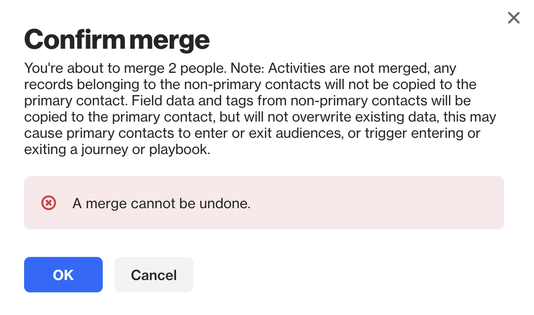
Merge all duplicates to a record based on interaction or age
To make a record with the most recent interaction (most recent engagement, most recently seen, or most recently entered a journey) or age (first created or last created) the primary for every duplicate record, click the Merge all button.
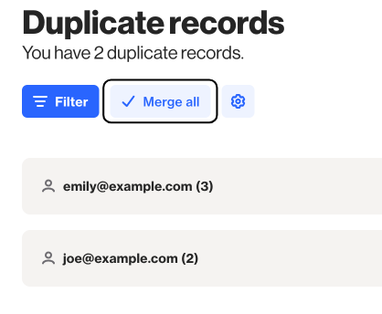
NOTE: Depending on your page settings (accessed via the cog icon), one of the records in the duplicate records list will be selected as Primary. The selected merge rule will become the primary merge rule for the Merge all option, however you can select one of the other options for identifying the primary record.
In the Merge all popup, choose the Merge rule to determine which of the duplicate records you want to assign as the primary record:
- Most recent engagement: The record that most recently interacted with your content, based on activities such as opening or clicking an email, clicking an SMS, clicking a push notification, or submitting a capture form, will be set as the primary record.
- Most recently seen: The record that most recently visited your website or interacted with a message or notification, as indicated by the person's "Last seen" field, which is updated with each interaction or touch, will be set as the primary record.
- Most recently entered a journey: The record that most recently entered (started) a journey will be set as the primary record, based on the "Started journey" activity.
- Last created: The record that was created last (the newest record) will be set as the primary record.
- First created: The record that was created first (the oldest record) will be set as the primary record.
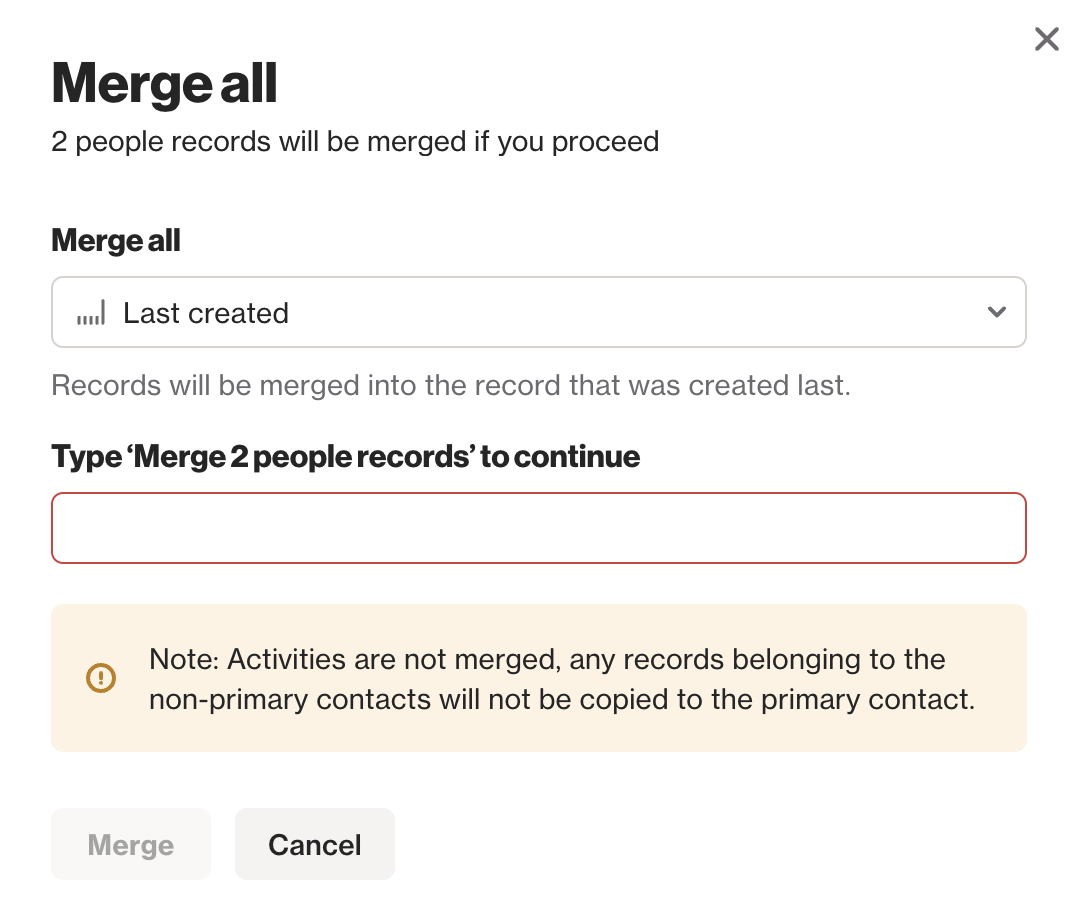
Then, type the required confirmation and click Merge to complete the merge.
NOTE: If there's no relevant data present for the merge rules Most recent engagement, Most recently seen, and Most recently entered a journey (such as engagement activity, last seen status, or journey start), the last (most recently) created record will automatically be assigned as the primary record.
How primary and non-primary records are merged
The consequences of merging primary and non-primary person records vary depending on the data types involved.
NOTE: When account records are merged, individuals linked to the non-primary account will NOT automatically transfer to the primary account record. Instead, they will simply become unlinked from the non-primary account.
Activities
- Activity data linked with the non-primary records will not be transferred to the primary record.
- The primary record will maintain only its own activity data.
Tags
- Tags associated with the non-primary record, which are not already present on the primary record, will be added to the primary record.
- For instance, if the primary record has a tag named London and the non-primary record has a tag named Tokyo, the primary record will acquire Tokyo (resulting in the merged record containing both tags: London and Tokyo).
Fields
Field data associated with non-primary person records will be transferred to the primary person record only if the primary record lacks a value for that specific field. Existing data linked with the primary record will remain untouched and won't be overwritten.
EX: Consider a field named Plan tier:
- If the primary and non-primary records possess different values for that field (e.g., the primary record has Gold while a non-primary record has Silver), the primary record will maintain its existing value (Gold).
- However, if the primary record doesn't have a value for that field, but a non-primary record does (e.g., the primary record has no value, but a non-primary record has Silver), the primary record will adopt the value from the non-primary record (Silver).
- If none of the records contain a value for that field, it will remain empty after the merge.
Merging Salesforce records
Concerning the merging of records, Ortto follows Salesforce as the authoritative source. Consequently, any records merged within Ortto will not reflect back to Salesforce.
However, in the scenario of merging Salesforce records directly within Salesforce, Ortto will interpret the merged (non-primary) records as deleted. Hence, if you have activated the Automatically archive records when linked record is deleted or removed feature for your Salesforce data source in Ortto, the merged record(s) will be archived within Ortto during a Salesforce sync.

- In this scenario, Ortto preserves the data linked with the designated primary record, as determined within Salesforce. Only activities, field data, and tags associated with the primary contact are retained, while those associated with the merged contact are archived alongside the record.
- This process differs from the merge rules outlined earlier for records merged within Ortto because the merge takes place within Salesforce. Consequently, it is not considered a merge within Ortto. Ortto simply manages the record in accordance with the information received from Salesforce and the settings configured for your Salesforce data source within Ortto.
- Therefore, any data not originating from Salesforce (e.g., custom or other data source activities) and any activities existing solely on the non-primary record within Ortto are not transferred to the primary record.
